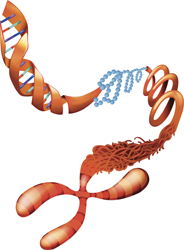Functional role of histone modifications
DNA is found in cells associated with proteins known as histones, in the form of chromatin. Although initially envisaged as mere structural components, it is now well established that histones are actively involved in DNA metabolism, transcription and repair. A plethora of histone modifications have been described (methylation, acetylation, and phosphorylation) but their functional role is still under investigation. Researchers of the EU-funded ′Role of histone modifications in dna damage response in mammals′ (HISTONEDDR) proposal focused on SCML2, a poorly described reader of histone modifications. SCML2 is a homologue of the Drosophila Polycomb family of proteins which form complexes implicated in transcriptional repression. SCML2 interacts with lysine residues of histones H4 or H3, and these modifications have been linked to the DNA damage response. Experimental analysis of the two SCML2 isoforms unveiled structural differences and altered subcellular localisation patterns. One of the isoforms (SCML2B) was shown to regulate cell cycle progression through direct contact with cell-cycle related genes. The SCML2A isoform contains the chromatin-binding domain. It mediates gene repression by using a combination of RNA binding, methylated lysine recognition and interaction with the Polycomb complex PRC1. Furthermore, both SCML2 isoforms were found to interact with USP7, a specific protease which stabilises members of the histone modification complex PRC1 as well as the tumour suppressor p53 under stress conditions. Overall, the HISTONEDDR study findings provide the first link between the mammalian Polycomb system and the cell cycle machinery. Both PRC1 and USP7 are implicated in various diseases and in ageing. Project activities bring us a step closer to comprehending the mechanism underlying their pathological impact.







